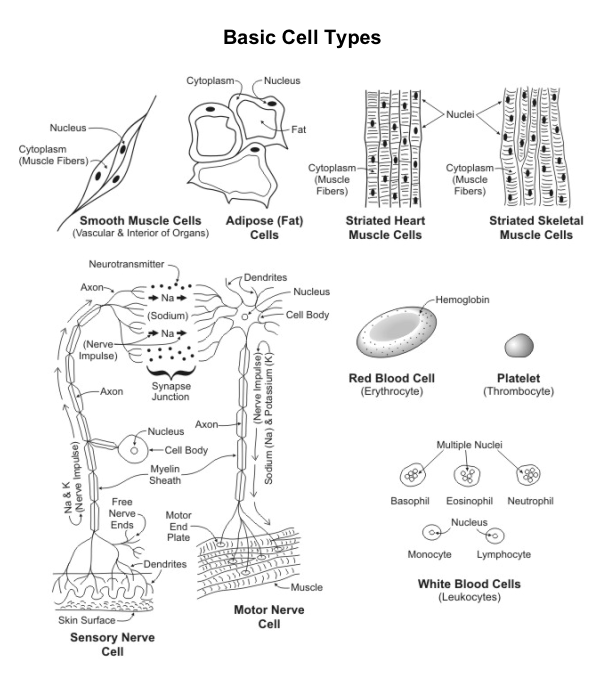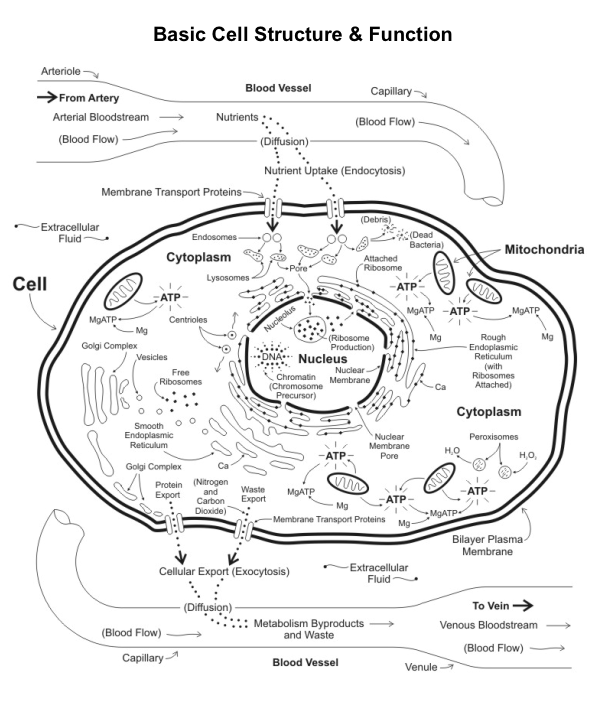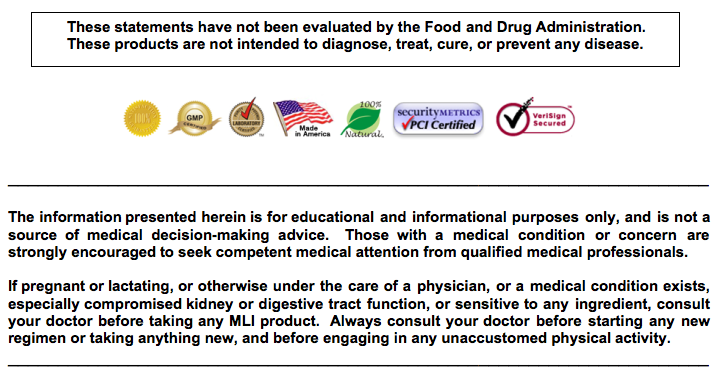Healthy Functioning Cells = Optimum Health & Maximum Longevity
Life begins and ends with the cell. The entire human body, every part – every organ, every structure, and all tissues – is composed of tiny living and dynamically functioning structures called cells. Each cell, though specialized for whatever body part it comprises, is fundamentally the same with three basic parts: 1. A selectively permeable protective outer membrane that allows nutrient molecules and mineral ions to go into the cell, and metabolism waste products to go out of the cell, through specialized receptors, gates and channels; 2. A central nucleus where DNA is located (except for red blood cells and eye lens cells which have very specialized functions and thus have a different internal structure); and 3. Numerous tiny and dynamic functioning organ-like structures inside the cell called organelles, which are suspended in a water-based jelly-like substance called cytoplasm. Each organelle has specialized functions, and each are contained within their own selectively permeable protective membrane.
Each cell is a tiny complex city of busy function.
The following diagrams illustrate the basic types of cells and how their appearance differs depending upon their particular purpose and function, and a fundamental view of the highly complex structure and function of a typical cell.
Perhaps the best known organelle are the mitochondria, often referred to as the cell’s “power plant,” of which there are several in each cell and make up about 25% of the total volume of a typical cell. The mitochondria provide the energy-producing chemical compound adenosine triphosphate (ATP), which bonds with magnesium (Mg) to form the energy complex MgATP, which drives the cell by releasing energy (i.e., energy transfer reaction) for cellular reactions when converted to the chemical compound adenosine diphosphate (ADP). Because of the energy requirement of the continuously functioning heart, heart muscle cells have about 5,000 energy-producing mitochondria per cell. By comparison, a typical skeletal muscle cell may only have about 200 mitochondria per cell. It is the mitochondria that drive the cells.
Cellular energy is produced in a complex sequence of biochemical reactions that starts with the ingestion of nutrients (such as carbohydrates, fats, and magnesium) that are broken down into their simpler form (carbohydrates into the simple sugar glucose, fats into fatty acids and glycerol, and magnesium into magnesium ions), for production of ATP molecules in the mitochondria (primarily from glucose), which bonds with magnesium ions to form MgATP, and then releases energy as it converts to ADP. The essential mineral magnesium is the facilitator of energy production.
This is how magnesium provides natural energy, which is especially noticeable in those who take magnesium supplements who have low magnesium and energy levels.
Assisting are the other nutrients: Protein – Which is broken down into its basic amino acid components that is reassembled into numerous peptides for structure and chemical formation; Vitamins – That primarily act as functional cofactors; Minerals – That are both structural and functional cofactors; and Water – Which is the fluid medium for all biochemical body functions. Protein can also be used as an energy source but is third in line, after the body-preferred carbohydrates (for immediate conversion to glucose) and dietary fat. Fundamentally, protein is for structure, carbohydrates are for energy, fats are for protection, vitamins are for function, minerals are for structure and function, and water is the basis for the body’s fluid environment.
Adenosine triphosphate (ATP) is the basic energy source for cellular function, metabolic reactions, synthesis of DNA, RNA and proteins, molecular transport across cell membranes, drives and maintains cell structure components, acts as a cell-signaling molecule (communication between cells), and is required for muscle fiber contractions and in this way meets the main energy requirement for body movement, organ function, and respiration. ATP is the cellular energy spark of life.
Like our body’s organs, each organelle has a specific function that contributes to the normal function, health and life of the cell. The quantity and quality of consumed nutrients determine cell function, health and life.
The raw materials that fuel the function of each cell are the nutrients we consume from food and drink, and from the air we breathe – oxygen, protein, carbohydrates, fats, vitamins, minerals and water (virtually all bodily chemical reactions occur in a water-based fluid environment) – all of which are vital for life. The quantity, quality and balance of these nutrients dictate how well the organelles function, which dictates how well the cells function, which dictates how well the organs, structures and tissues function, which dictates how well the body functions.
How well the cells function determines their health and longevity, which determines our health and longevity. Cells that have inadequate and/or improperly balanced nutrients can cause cellular dysfunction. Ongoing cellular dysfunction causes cell damage, health problems, premature aging, and eventual cell damage and demise. Cellular dysfunction, damage, demise and decay are what have been identified as “aging.” Thus, the importance of proper nutrition – it truly is the basis of health.
The equation is real simple: Every bite of food and every sip of a drink is either on the plus side (part of proper nutrition which supports health), or is on the minus side (part of improper nutrition that chips away at health).
The kinds of foods that make up proper nutrition are foods that originate from the land and sea, that is, plant-based foods and seafood: A variety of fresh vegetables and fruits, legumes (beans, lentils, peanuts, peas and soybeans), fish and seafood (including sea vegetables), 100% whole grains, olive oil, nuts, seeds, and a select few animal-based foods like fresh free-range eggs, a little cultured nonfat dairy (yogurt), a little soft white cheese, and occasional fresh meat. This kind of a healthy diet might be thought of as a natural blend of the “Mediterranean Diet” with a strong Asian seafood influence, resulting in what has become known as the MediterrAsian Diet (or simply the “Med-A Diet”). The “Med-A Diet” (as it is sometimes referred to) contains very little (if any) refined carbs or sugar-laden foods, contains no hydrogenated oils or trans fats, and should probably contain no fats that have undergone interesterification. Interesterification of fats is a process that modifies the molecular structure of oil similar to the way hydrogenation does, is used to make the oil more solid for use in such products as margarine spreads, and carries with it untold long-term health consequences when consumed on a regular basis. From a health standpoint, natural butter (in moderation) is better than man-made margarine spreads.
If the food grows from the ground and is fresh and minimally processed, or comes from the ocean or streams, then it is part of what constitutes proper nutrition, and is what supports health and longevity. Proper nutrition is the basis for what is called the human “Health Span” (i.e., healthful longevity). It is not only how long we live, but also how well we live; or, to put it another way: How long we live well.
If the food is highly processed food, man-made (ever seen a soda stream or a potato chip tree?), junk food, sweets, highly refined food, most fast-food, refined carbs (sugar, refined grain products, and alcohol), or predominantly acid-producing animal foods (meat and dairy products), then it is part of what constitutes improper nutrition, which is at the heart of most health problems, premature aging, and an abbreviated life span. When it comes to longevity and health (especially heart health), those who chronically consume an improper diet are their own worst enemy.
The worst part of an improper diet, that will eventually cause the most critical health problems, is the habitual consumption of: Refined carbs (sugar, refined grain products, and alcohol), trans fats (foods made with hydrogenated or partially hydrogenated oils), a preponderance of acid-producing animal foods (meat and dairy products), foods that stimulate or exacerbate free radicals (refined carbs, trans fats, excess animal foods, and processed meats), and those foods that cause or contribute to unbalanced calcium metabolism (food that is highly processed, manufactured food, sodas and diet sodas, meat and especially dairy products, refined carbs, and high intakes of calcium fortified foods and calcium supplements). (See “Unbalanced Calcium Metabolism” and “The Role of Calcium” for more details.)
Each person is born with one important possession that outweighs all others: Their last heartbeat. What we do (or don’t do) along the journey of life will largely determine when that will be. What we do or don’t do is what we call “lifestyle.” And lifestyle is by far the strongest determining factor for our health (especially heart health), even more so than genetics. Genetics only loads the gun, while it is a poor lifestyle that will pull the trigger. A healthy lifestyle can change the whole equation, creating a balance strongly in favor of good health. And the basis of good health is the balance and consumption of the right kind of adequate nutrients: Protein (primarily from fish, seafood and legumes), the “good carbs” (from a variety of fresh vegetables and fruit, and 100% whole grains), the “good fats” (omega-3 fatty acids from fish and seafood, and monounsaturated fats from nuts, seeds, and extra virgin olive oil), and the very important micronutrients: Vitamins and minerals.
While vitamins often get the spotlight, minerals are kind of like the neglected stepchild. In reality, minerals are actually more important for the structure and proper function of the cells (and of the entire body), while vitamins actually act more like coenzymes that assist in the various functions. Minerals are the actual heroes, while vitamins are the invaluable sidekicks.
As with anything that is consumed, to be truly effective and healthful, minerals need to be kept in balance.
Two of the most important nutrients that must be kept in balance, and that especially impact cardiovascular health, are the minerals calcium and magnesium. On the cellular level, calcium and magnesium have several important functions that are either synergistic or antagonistic. One of the main functions of magnesium (Mg) is to bond with ATP (the energy molecule produced by the mitochondria organelles) to form the energy complex MgATP – the source of energy that drives each cell.
Calcium triggers muscle contractions, while magnesium provides muscle relaxation – affecting all the body’s muscles: The skeletal muscles (which provide body movement), the organ muscles (which provide functional support), the blood vessel muscles (which provide contraction and dilation), the diaphragm (which facilitates breathing), and the hardest working muscle of all, the heart muscle (which allows the heart to beat and pump blood throughout the body). Obviously, balance between these two important minerals is critically important. Too much calcium and too little magnesium (which is common) can be a real problem – the result of habitually consuming too much meat and dairy and not enough fruits and veggies.
Of particular importance for cardiovascular health is how magnesium functions. It is well-established that magnesium is a natural calcium channel blocker, and as such it controls and regulates how much calcium enters each cell. Over time, chronic excess and unbalanced calcium most affects – and damages – the endothelial cells that line the interior of the arteries, where excess unbalanced calcium comes into direct contact with the endothelial cells via the bloodstream. Such endothelial cell damage sparks inflammation and is the underlying trigger of arterial dystrophic calcification. One of the most important things that magnesium does is to balance calcium metabolism, which breaks the cycle of endothelial cell dysfunction, damage, inflammation, and dystrophic calcification (calcium deposits in soft tissues).
Once the cycle of endothelial cell dysfunction, damage, inflammation, and dystrophic calcification has been broken, then the continued intake of the essential mineral magnesium helps return the body to its normal function, balance, and healthy condition known as “homeostasis.” Nutrient provided homeostasis is what is known as “orthomolecular homeostasis.”
Nutrient balance is the key to a normally functioning cardiovascular system (i.e., the function of the heart and blood vessels). A normally functioning heart is a healthy heart. And, a healthy heart is what provides youthful vitality.
Thus, the real secret of health and longevity is to remain Young at Heart. The real secret to having a healthy heart is to balance calcium metabolism, and the only thing that can balance calcium metabolism is the essential mineral magnesium. This is why magnesium is known as the most heart-healthy nutrient there is. A healthy heart is the most important aspect of increasing healthful longevity. You’ve got to have a healthy heart if you expect to increase your “Health Span.”
It is a sad fact of life that our bodies deteriorate as we age. If we do nothing to slow the deterioration it will accumulate, eventually resulting in an abbreviated life span. We’ve all heard stories of someone who seemed to be healthy but then suddenly and quite unexpectedly their heart gave out. What is most important for life and a healthy heart is what we cannot readily see: The condition of our body on the inside – especially the condition of the heart and blood vessels (notwithstanding the advances made in recent years with heart scan imaging and Doppler ultrasound technology).
As we age our body goes through some dramatic changes – inside and out. Our skin, the body’s largest organ, provides an easy reference as to how we are aging inside. As we age, our skin develops the obvious signs of aging as a manifestation of the deterioration of its cells, plus the cells no longer function as well as they once did when they were younger cells. The lines and wrinkles, the weird little skin growths, the slowed healing of wounds, the changed skin texture and sagging, are all the outward expression of what is happening to the rest of our organs, tissues and structures inside our body – on the cellular level. In fact, “cellular dysfunction, damage, demise and decay” are what have been identified by researchers as what constitutes “aging.” Thus, the only thing that can impact aging in any meaningful way is that which can prevent or inhibit cellular dysfunction and damage (the starting point of aging), and improve or extend normal cellular function. So far, the only known things that can do that are antioxidants and the essential mineral magnesium.
So, the Real Secret of Health & Longevity is to support the healthy function of the cells. And, the best thing to help support the healthy function of the cells is to provide the cells with a balanced supply of the essential nutrients, especially the mineral magnesium and the antioxidant nutrients such as vitamin C.
(See “Cells – The Basis of Life & Aging,” “The Importance of Magnesium & Vitamin C,” “Potentiated Magnesium,” “How pMg Works,” “Magnesium,” and “Vitamin C” for more information.)




